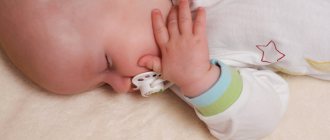Conditions for sleeping a newborn
In order for an infant to have sound and deeper sleep, he needs the following conditions:
- clean air in the room;
- temperature not higher than 25°C (ideally 20°C);
- correct humidity - about 60-70%;
- lack of bright light, loud sounds.
Naturally, the newborn’s room must be washed and the dust wiped off. If it is a nap, then the curtains are drawn. The baby himself does not need to be wrapped in a blanket if the temperature in the nursery is above 22°C. Overheating can have unpleasant health consequences.
Sleeping positions
It is very important in what position the baby sleeps, because so far he spends most of his time sleeping. Let's look at comfortable positions in which it is better to place the baby.
On the side
The side position is the safest
The safest sleeping position for a baby is on its side. This is how pediatricians, as well as doctors in maternity hospitals, advise placing babies (at least for the first time). The point is the anatomical features of the structure of the stomach and esophagus of infants, namely, the absence of a pronounced cardiac sphincter. Therefore, after feeding, the baby may burp profusely. At this point, it is better to lay him on his side to avoid the risk of choking.
Semi-sideways
This is an even safer position than sleeping on your side. Sleeping halfway is beneficial for children who frequently spit up or who suffer from colic. This position promotes better passage of gas.
To prevent the child from rolling over and taking other positions, he must be placed correctly. You need to place a diaper or blanket rolled up under the backrest. It is also necessary to ensure that the baby does not scratch himself; this can be avoided by putting scratchers on him.
Advice: the child must be periodically turned over to the other side, otherwise torticollis may occur.
On the back
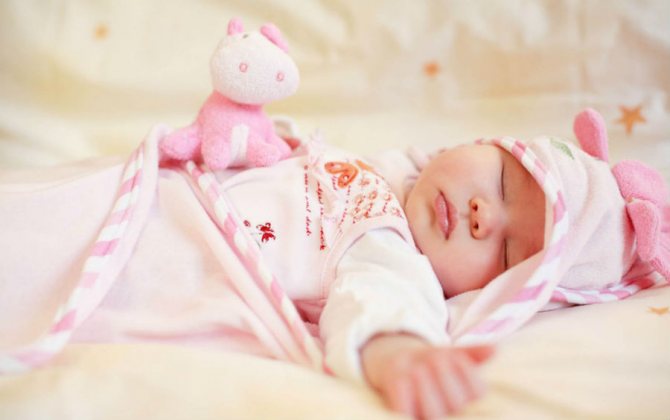
When the baby sleeps on his back, his head should be turned to the side
Sleeping on your newborn's back is both beneficial and dangerous. It is useful because it is physiological and natural for him. Dangerous because it's a baby. In a supine position, he may choke on the regurgitated masses.
Adviсe:
- When laying a newborn on his back, the head should be turned to the side and secured with a diaper roll so that he cannot turn on his own.
- The position of the head must be changed periodically to avoid torticollis.
- To prevent the baby in this position from scratching and waking himself up with his hands, it is better to swaddle him. If the baby does not like to lie swaddled, he is nervous, then it is recommended to lay him, for example, on his tummy.
The position on the back is not recommended if the baby is diagnosed with hip dysplasia, if he has signs of muscle hypertonicity (he will constantly twitch his arms, preventing him from sleeping), as well as with colic (with excessive gas formation, the newborn will not be able to sleep soundly).
On the tummy
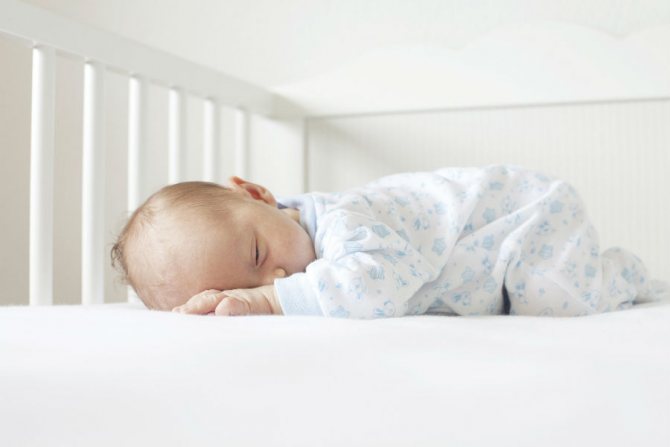
The best position is on the tummy: prevents colic, is a prevention of infant mortality syndrome
The position on the stomach is a prevention, firstly, of colic (in this position the digestive system works well, gases pass better), and secondly, infant mortality syndrome, one of the reasons for which is, again, the danger of choking when regurgitating. Positioning on your tummy will prevent the unpleasant consequences of regurgitation.
In addition, this position strengthens the muscles, bones of the back and neck, and over time it will be easier for the child to learn to hold his head.
If your baby likes to sleep on his stomach, then certain safety precautions must be followed:
- purchase a hard mattress, preferably an orthopedic one;
- sleep without a pillow;
- do not put oilcloth sheets in the crib;
- It is better to hang toys above the bed, rather than placing them at the head of the baby.
But even if these precautions are observed, it is better to look after the baby while sleeping on his stomach.
In the fetal position
If a child has been sleeping for more than a month with his legs pulled up to his tummy and his arms pressed to his chest, this may indicate muscle hypertension (hypertonicity). But if after 3-4 weeks the baby straightens up and sleeps in normal positions, then there is no reason to worry.
Important! No matter what position the baby sleeps in, from time to time it is necessary to turn him over to the other side or change his position in order to avoid tissue tracking, deformation of the unstable bone skeleton, and compression of veins and muscles.
What position does your baby sleep in?
The sleeping position of a child can tell a lot about his character. Sloboda looked into the peculiarities of children's sleep.
TEMPERATURE FOR SLEEP In babies under 4 months, physiology is responsible for postures. Babies at this age sleep with their arms and legs bent and their fists clenched. This is due to increased muscle tone, which returns to normal over time. After four months, babies react to the temperature in the room in their sleep. Cold - it will curl up, hot - it will “open up”. “The child can sleep the way he wants, in any position,” says pediatrician Sergei Sosonkin . “They say that you can determine what the baby is sick from by his sleeping position.” I don't think that's true. In general, one sign cannot determine what the problem is; it is better to see a doctor.
PETS SLEEP ON THE BACK By the “sleepy” postures of older children, you can recognize their character. SLEEPING IN A CURL. These kids are like buds that don’t want to open. They subconsciously do not want to part with childhood and need protection. They love if they are taken care of. ON THE BACK. If the baby sleeps on his back, he is sociable and reasonable, and has a friendly attitude towards others. But at the same time he lacks perseverance and assertiveness. Therefore, their academic success is mediocre. This position in a dream is characteristic of a “favorite” child who is indulged by his parents. ON THE BElly. Does your baby sleep with his butt up, hugging a pillow? He is efficient and stubborn, he likes everything to be sorted out. But... very shy! ON THE SIDE. The baby is obedient and balanced. Quickly adapts to different situations, but at the same time does not have courage, energy and perseverance, and does not strive to be a leader. Does your child like to sleep cuddled with toys? So it makes him feel better. This is especially true for children who have recently begun to sleep without their mother. Does your baby cover himself with his arms in his sleep? This is also protection. After all, in a dream a person is vulnerable and does not control what is happening around him. By the way, not only children, but also adults do this. “By the way the baby sleeps, first of all, you can understand the emotional state of the child,” says psychologist Olga Radzyuk . - If the baby's sleep is calm, then everything is in order. If a baby cannot fall asleep for a long time and starts in his sleep, this is the first sign of neuroticism.

5-year-old Tula Sofya Anokhina loves to sleep. Especially in the mornings, when mom wakes me up for kindergarten. But if Sophia got enough sleep, then hold on, teachers!
| Is your child curled up? And he also sucks his finger in his sleep? The baby subconsciously does not want to grow up and really needs your support! |
| Does your baby sleep on his side all the time, with his hands under his cheek? He lacks courage and persistence. Instill leadership qualities in him! |
| Is your baby resting on his stomach? Help him overcome his shyness. Entrust more “adult” matters, support and encourage. |
| Very free pose. Your baby is open and sociable. The only thing he lacks is pressure and grip. Teach him perseverance, patience and hard work. |
Dear readers! Is your baby's birth story worth telling? Call tel. 23-31-55. Oksana KUZNETSOVA .
Going to bed
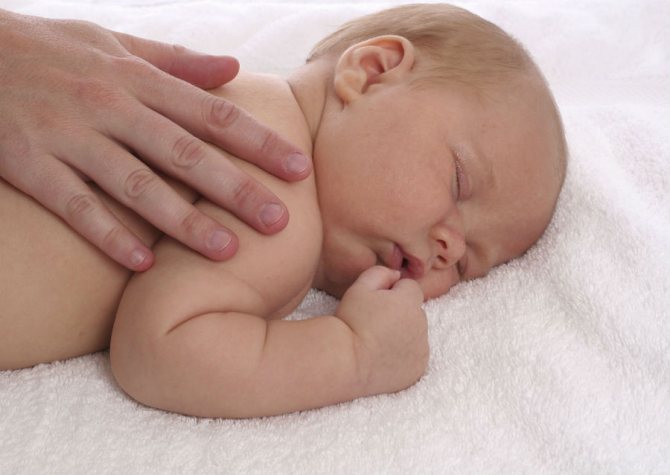
When laying your baby down, you need to stroke him or pat him lightly to calm him down.
Studies of infant behavior show that already in infancy a child remembers the sequence of actions that take place, and if something is missed, he will begin to be capricious and will not be able to fall asleep for a long time. It is correct to position the baby so that this process takes place quickly and painlessly, for which purpose before going to bed it is advisable to repeat the same actions, at the same time, in the same sequence.
- To calm the child and improve sleep, he is bathed in water with herbs, given a light massage with stroking, and then fed.
- You should not put your newborn down immediately after feeding. It's good to lift him upright for a few minutes so he can burp out excess air.
- When putting the baby to bed, the mother can sing the baby a lullaby in a low voice, quietly stroking and patting him goodnight.
We recommend reading: Comfortable temperature for a newborn
Newborn bedding
A one-month-old baby sleeps 18-19 hours a day, older children (3 months to a year) sleep less, but still at least 15-16 hours. That is, almost all the time. Therefore, the task of parents is to decide where to sleep the baby and arrange his sleeping place.
Some parents buy a crib in advance, others put their baby to bed with them. On the one hand, this is convenient for both parents and children, since they do not need to get up at night to feed, and the baby is calmer at the mother’s breast. On the other hand, this is dangerous, since falling asleep parents can crush the baby. Pediatricians warn: you should not accustom your child to his parents’ bed!
Crib
Requirements: safety, hygiene, moderate hardness. Pediatric specialists and orthopedists recommend a hard, dense orthopedic mattress that bends slightly under the weight of the baby. This is primarily the prevention of spinal curvature.
Due to the active development of the child’s skeletal and muscular system, it is forbidden to lay him out on a soft surface for up to a year, especially on down mattresses.
A firm or moderately firm mattress is part of the prevention of infant mortality syndrome. Even with his nose buried in it, the baby will not suffocate, since a flat surface without creases will not be able to block the baby’s oxygen.
Since children love to chew on their crib (especially when teething), it is better if it is not well sanded and varnished.
Positioner cushion
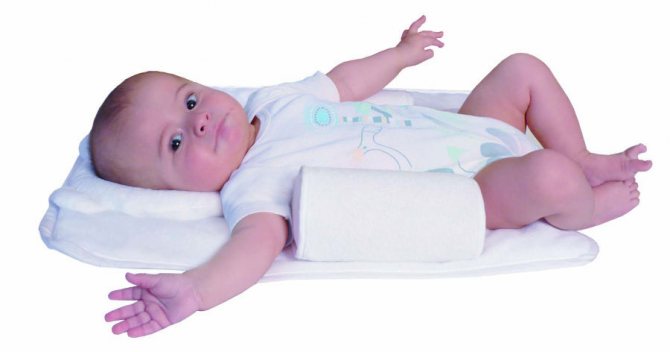
A positioner pillow will keep your baby in the best position for him.
Very convenient when caring for a baby. Various modifications of such pillows, mattresses, blankets, pillowcases, cocoon beds for newborns help keep the baby in the position in which he was put to sleep, fixing the head in the desired position. With a positioner pillow, your baby should sleep soundly.
Buckwheat pillows
Recommended for newborns by neonatologists. Such orthopedic pillows filled with buckwheat husks easily follow the contours of the baby’s head and neck in any position and contribute to the correct formation of the spine and cervical curve. In addition, the pillow has a massaging effect, improves blood supply to the head and neck, and calms the baby well.
Cocoon diapers
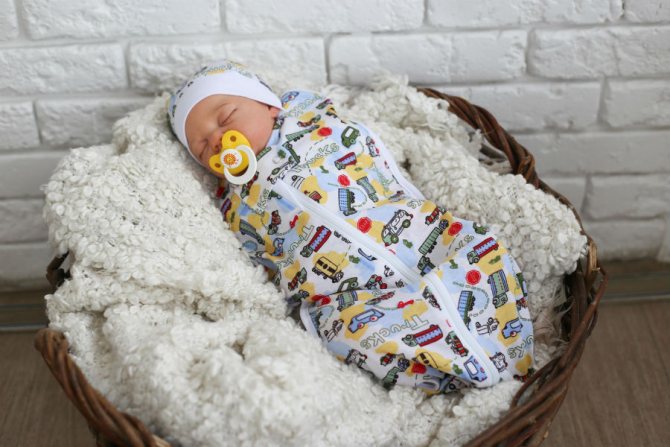
A cocoon diaper will provide a restful sleep for your baby
They come with zippers or Velcro, are easy to use, and allow you to quickly secure the baby’s arms and legs, leaving him freedom of movement. Such soft swaddling prevents restlessness during sleep, since the baby cannot wake himself up and scratch himself with his hands. Such cocoons give the baby the impression of being in the womb.
The postures of a sleeping child will tell about his state of mind
Many children, when sleeping, take positions that shock their parents. You shouldn’t be scared, watch the baby and you will learn a lot of interesting things about his state of mind. The postures of a sleeping child are not accidental; they reflect his attitude towards himself and the surrounding reality, his internal conflicts and contradictions.
If children do not know how to explain to their parents what worries them, then older children often hide their problems from their parents and experience them alone, which can affect their character and psyche.
The test at the end of the article will help you analyze children's postures and understand their psychological reason.
The body positions adopted by the child over a long period of time: a week, a month, deserve attention and analysis. Contents:
Hide
- 1. Why sleep poses are full of meaning
- 2. At what age are sleep positions formed?
- 3. The stages of growing up are reflected in the poses.
- 4. What the child’s sleep positions will tell you about. Test
- 5. Summary
Why sleepy poses are full of meaning
Each of us has two predominant sleep positions. In the first we fall asleep, we can choose and control it. We take the second, main pose, completely immersed in sleep, when consciousness turns off. It is not subject to our conscious control and reflects the very essence of our individuality. In the main position we are most safe and comfortable; we spend most of the night sleeping in it and wake up in the morning. It is this basic pose that deserves analysis.
At what age are sleep positions formed?
A person begins to determine his individual sleep position at approximately 3 months of age, when the stages of sleep are formed and the baby has mastered his body and can move and roll over freely and independently.
In the first years , children experiment when choosing their favorite body position in sleep. At this stage, they may have very exotic poses, for example, “sphinx” - standing on their knees, head lying on the pillow, back raised up. “Sphinx” is a child’s protest to the world of sleep; he does not like to be forced into bed.
By the age of seven, the basic character of a little man and a certain position of the body in sleep are formed.
The stages of growing up are reflected in the poses.
Very often, sleepy positions change during puberty, which is explained by the most complex changes in the psyche and body of a teenager. Thus, in the practice of Samuel Dunkell, a psychoanalyst and psychiatrist, there was a characteristic case.
At the age of 12, the girl was subjected to a minor sexual incident, which affected her sleeping position: from the “semi-fetal” position, the girl moved to the “prostrate” position, and began to occupy the center of the bed. Read more about these poses here.
This change of postures clearly reflects the attitude to life in this period: a teenager, feeling himself in danger, abandons a comfortable posture and moves to a protective one, wanting to control his emotions and events not only while awake, but also during sleep.
When a difficult stage of puberty (or any other stage accompanied by mental stress) passes, the child can again change his position and return to his previous one. Or find a new one that reflects its current state.
Sleeping positions are finally fixed after 18-19 years, when the final abandonment of childhood lack of independence occurs.
What a child's sleep positions will tell you about. Test
Write down the letters you choose.
1. Baby sleeps:
a) Lying on your side or back, hands under your cheeks; b) Curled up into a tight ball; c) Stretched out on your stomach; d) It’s not clear how.
2. Head:
a) On the pillow; b) Buried in a pillow; c) Near the pillow; d) Under the pillow.
3. Hands:
a) On a pillow, lying symmetrically to each other or slightly bent at the elbows; b) One is free, and the other is elastically compressed; c) Hold a toy, pillow, blanket or sheet firmly; d) The child wrapped his arms around himself.
4. Brushes:
a) Unclamped, free and open; b) One is compressed and the other is open; c) Clenched into fists; d) Cover your face.
5. Legs:
a) Spread freely; b) One leg is bent and the other is lying freely; c) Caught on the edges of the bed; d) Intertwined or pressed against the body.
6. Position in bed:
a) In the very center; b) Diagonally; c) Across the mattress or along it; d) Huddled in the corner of the crib.
7. Blanket:
a) On the baby, as expected; b) thrown off or under a child; c) Twisted around the body; d) On the torso or head, legs sticking out.
8. Pose:
a) Sleeps like a princess or prince, reclining freely and comfortably; b) “Sphinx” - the butt is raised up and the head is down; c) Curled up; d) A doll wrapped in a blanket.
9. Does he hold onto anything when he sleeps?
a) No, I even dropped my favorite toy; b) Yes, he grabbed the bed with his hands; c) Yes, he clings to the bed with his legs; d) Hugs itself.
10. In a crib:
a) Slight disorder; b) Relative disorder; c) The heap is small; d) Complete chaos.
11. Your son (daughter) does not sleep:
a) Curled into a knot; b) Lying on your back with your legs and arms spread out; c) On the side, hands under the cheek; d) Spread loosely on your stomach.
12. In the morning:
a) You see a slight disarray in the bed consisting of a child, a blanket, a pillow; b) The baby hugs a pillow and is tightly wrapped in a blanket and sheet; c) The child comes running to your bed; d) You understand that you won’t be able to sleep for a little while longer.
Analyze which letter you chose most often.
a) Mental comfort, confidence. The child feels the support and approval of his family and knows that he is loved. He is full of self-respect and grows up free and happy. The baby is comfortable and safe in the world around him, he knows no fears.
b) Ready for defense. The child senses danger from which he is trying to hide or protect himself. Something worries him in his daytime life. The source of worries can be one’s own parents, peers (in the yard, garden or school), other adults (teacher, teacher, coach), some thing (a boy was forced to wear a hat like a girl’s, and they laugh at him).
The surrounding world is perceived as hostile. The little man is not ready to share his fears with his family, but tries to hide them. He is afraid that his experiences will not be understood, but he does not know how to resolve the situation on his own.
c) Uncertainty. The child experiences anxiety and confusion, which deprives him of confidence. He does not trust the world around him, tries to avoid surprises, and therefore does not allow himself to relax even when he sleeps. Mental stress is caused by any changes. The child tries to find support from loved ones, not counting on his independence. However, he wishes to be independent. This contradiction makes him vulnerable.
d) Anxiety. The child is struggling with something, maybe with you or with himself. Apparently, situations that do not suit him are happening more and more often. He is forced to come to terms with what is not to his liking. Why? What reasons force him to hide his true emotions and desires? Only his body openly declares this protest in a dream: “I don’t want to see, hear or know anything!” The baby experiences anxiety and lacks security and stability.
Summary
When analyzing the postures of a sleeping child, remember: they reflect the baby’s state of mind at the moment, and may indicate the onset of serious problems.
The straighter the body is in sleep, the more symmetrical the legs and arms are, the more comfortable the baby is in life, the more adapted he is to it. And vice versa: a twisted, knotted body speaks of internal conflicts, that the world is perceived as aggressive.
Of course, you can shift your sleepy child to a more comfortable position, but will this solve his problems? Help your daughter or son deal with their feelings.
How to help? Listen, support, warm with your love. Try to look through the eyes of a child at the world around him, what worries him, what is he afraid of? It is very important for a growing person to feel approval and support so that he grows up free, creative, and dreaming. Even infants perfectly perceive affectionate words: “Sleep, my beloved, peacefully. Mom is nearby, mom will protect you.”
If the child cannot or is embarrassed to explain what exactly is bothering him, invite him to play a game: take turns with you to tell or draw what he is dreaming about. The plot of a dream can indicate the source of worries and fears.
As soon as the problem is resolved, your baby will take a comfortable position in his sleep.
I wish your children and you the most comfortable sleeping positions and peace of mind.
Test authors: .
required!
On this topic:
- Exotic positions during sleep will tell you about internal problems.
- The positions of the arms and legs in sleep carry important information.
- Sleeping positions together will tell you about relationship problems.
- How postures change due to illness.
- Night terrors in children: difference from nightmares, how they manifest themselves, reasons, how to help a child.
- Why do children grind their teeth, how dangerous is it?
Sleepwear
What a baby sleeps in depends on several factors: the temperature in the apartment, the time of year (in the summer you don’t have to dress the baby at all, leaving only a diaper), his well-being, age, etc. The most comfortable clothing is a jumpsuit with scratches. It does not restrict movement and protects the baby’s delicate skin from its own sharp nails. It's warm and easy to put on and take off, which is especially good for parents who use diapers. The jumpsuit is ideal for children of both sexes.
These recommendations should definitely be taken into account, especially if parents want their child to sleep peacefully throughout the night. And if the child sleeps peacefully, then mom and dad also sleep, which gives them the opportunity to feel full of strength and desire to communicate with their baby.
What does a child's posture indicate during sleep?
Degtyareva Anastasia
What does a child's posture indicate during sleep?
Dear moms and dads!
Did you know that a child's sleeping position can tell you about his psychological state?
So, the child has fallen asleep , look carefully at how he sleeps.
Lies on your back in the center of the bed, arms and legs spread out, relaxed. Arms at your sides or at head level, with your elbows slightly bent. The head is slightly thrown back. “open” position This pose speaks of spiritual comfort , the child feels good and comfortable in the world around him, he is confident in himself and in his loved ones.
On the side is another good position : knees slightly bent, hands under the cheek or slightly bent, limbs lying symmetrically. This pose speaks of physiological comfort, a feeling of reliability, and balance. The child is quite adapted to the conditions of the surrounding world.
On your stomach, legs extended, arms at your sides or level above your head. The pose talks about the vulnerability and vulnerability of the child . He doesn’t like surprises, he tries to control (hide)
your emotions.
Sleeping in this position diagonally across the bed indicates an even greater desire of the child to protect himself from the outside world.
On his knees: the child draws his legs in , the head is lower, the butt is higher. This pose is a signal of protest . Either the child resisted falling asleep until the last moment, or did not agree with some life event.
“Curl”: position on the side , the face is hidden, arms and legs are tucked, the child can wrap himself up or cover his head with a blanket. This position is a sign of high anxiety, restlessness, insecurity, vulnerability, a desire to hide from problems and troubles. The more “compressed” the figure is, the stronger the emotional tension.
Other features of poses:
the child seems to be grasping the bed with his feet - a sign of resistance to life;
legs are strongly bent in any position - does not allow himself to relax, as if he is ready to wake up and immediately run;
hands clenched into fists in a lock - a sign of defense;
one hand is relaxed, the other is clenched - a conflict with someone around is possible;
the child seems to be fencing himself off, covering himself with his hands - in real life he does not want to see, hear, feel something, this is a posture of protection ;
A child sleeping in an embrace with a toy is easily wounded, emotional, and needs the affection and attention of loved ones.
Attention! The sleep positions listed above and their interpretation are relevant for children from about two years of age (each individual, since until this age physiologically determined positions are preserved. For example, bent arms and legs, clenched fingers in a baby, sleeping on the stomach in a two-year-old baby, Sleeping diagonally across the bed in a one and a half year old baby; in many preschool children it persists until about 5-6 years of age - this is completely normal and is not read as alarming signs.

